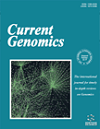- Home
- A-Z Publications
- Current Genomics
- Previous Issues
- Volume 12, Issue 4, 2011
Current Genomics - Volume 12, Issue 4, 2011
Volume 12, Issue 4, 2011
-
-
Editorial [Hot Topic: Clinics, Epidemiology and Genetics of Retinitis Pigmentosa (Guest Editor: Francesco Parmeggiani)]
More LessInherited retinal dystrophies represent the most frequent hereditary disorders of the ocular posterior segment. The chronic eye diseases included in this heterogeneous group of genetic degenerative disorders of the retina are also habitually named retinitis pigmentosa, a term coined by Donders more than 150 years ago. Taking into account all the different forms of retinitis pigmentosa (RP), among the general population Read More
-
-
-
Retinitis Pigmentosa: Genes and Disease Mechanisms
More LessRetinitis pigmentosa (RP) is a group of inherited disorders affecting 1 in 3000-7000 people and characterized by abnormalities of the photoreceptors (rods and cones) or the retinal pigment epithelium of the retina which lead to progressive visual loss. RP can be inherited in an autosomal dominant, autosomal recessive or X-linked manner. While usually limited to the eye, RP may also occur as part of a syndrom Read More
-
-
-
Clinical and Rehabilitative Management of Retinitis Pigmentosa:Up-to-Date
More LessThe term retinitis pigmentosa (RP) indicates a heterogeneous group of genetic rare ocular diseases in which either rods or cones are prevalently damaged. RP represents the most common hereditary cause of blindness in people from 20 to 60 years old. In general, the different RP forms consist of progressive photo-receptorial neuro-degenerations, which are characterized by variable visual disabilities and considerable so Read More
-
-
-
Good Epidemiologic Practice in Retinitis Pigmentosa: From Phenotyping to Biobanking
More LessInherited retinal dystrophies, such as retinitis pigmentosa (RP), include a group of relatively rare hereditary diseases caused by mutations in genes that code for proteins involved in the maintenance and function of the photoreceptor cells (cones and rods). The different forms of RP consist of progressive neurodegenerative disorders which are generally related to various and severe limitations of visual performances. In the co Read More
-
-
-
Diagnostic Challenges in Retinitis Pigmentosa: Genotypic Multiplicity and Phenotypic Variability
More LessAuthors: Susie Chang, Leah Vaccarella, Sunday Olatunji, Colleen Cebulla and John ChristoforidisRetinitis pigmentosa (RP) is a heterogeneous group of inherited retinal disorders. Diagnosis can be challenging as more than 40 genes are known to cause non-syndromic RP and phenotypic expression can differ significantly resulting in variations in disease severity, age of onset, rate of progression, and clinical findings. We describe the clinical manifestations of RP, the more commonly known causative gene mutations, a Read More
-
-
-
Therapeutic Challenges to Retinitis Pigmentosa: From Neuroprotection to Gene Therapy
More LessSyndromic retinitis pigmentosa (RP) is the result of several mutations expressed in rod photoreceptors, over 40 of which have so far been identified. Enormous efforts are being made to relate the advances in unraveling the pathophysiological mechanisms to therapeutic approaches in animal models, and eventually in clinical trials on humans. This review summarizes briefly the current clinical management of RP and fo Read More
-
-
-
Keeping the Balance Between Proliferation and Differentiation:The Primary Cilium
More LessAuthors: Florencia Irigoin and Jose L. BadanoPrimary cilia are post-mitotic cellular organelles that are present in the vast majority of cell types in the human body. An extensive body of data gathered in recent years is demonstrating a crucial role for this organelle in a number of cellular processes that include mechano and chemo-sensation as well as the transduction of signaling cascades critical for the development and maintenance of different tissues and organs Read More
-
-
-
Paramutation: Just a Curiosity or Fine Tuning of Gene Expression in the Next Generation?
More LessBy Roberto PiluGene silencing is associated with heritable changes in gene expression which occur without changes in DNA sequence. In eukaryotes these phenomena are common and control important processes, such as development, imprinting, viral and transposon sequence silencing, as well as transgene silencing. Among the epigenetic events, paramutation occurs when a silenced allele (named paramutagenic) is able to silence Read More
-
Volumes & issues
-
Volume 26 (2025)
-
Volume 25 (2024)
-
Volume 24 (2023)
-
Volume 23 (2022)
-
Volume 22 (2021)
-
Volume 21 (2020)
-
Volume 20 (2019)
-
Volume 19 (2018)
-
Volume 18 (2017)
-
Volume 17 (2016)
-
Volume 16 (2015)
-
Volume 15 (2014)
-
Volume 14 (2013)
-
Volume 13 (2012)
-
Volume 12 (2011)
-
Volume 11 (2010)
-
Volume 10 (2009)
-
Volume 9 (2008)
-
Volume 8 (2007)
-
Volume 7 (2006)
-
Volume 6 (2005)
-
Volume 5 (2004)
-
Volume 4 (2003)
-
Volume 3 (2002)
-
Volume 2 (2001)
-
Volume 1 (2000)
Most Read This Month
Article
content/journals/cg
Journal
10
5
false
en


